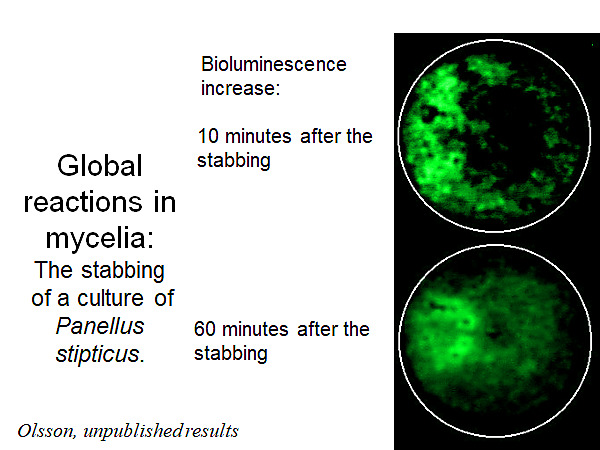Fungi Research Platforms
The Cornell University Mushroom Blog - https://blog.mycology.cornell.edu/category/fungi/
https://www.mycosphere.org/ - Research papers on fungi collected
Elise Elsacker has several published articles on mycelium materials which are extremely relevant: https://www.researchgate.net/profile/Elise-Elsacker
Fungal Architectures is a new cross-disciplinary research project that seeks to develop a fully integrated structural and computational living substrate using fungal mycelium for the purpose of growing architecture. https://www.fungar.eu/
Articles, papers, forum posts on mycelium
The Effects of Temperature and Nutritional Conditions on Mycelium Growth of Two Oyster Mushrooms (Pleurotus ostreatus and Pleurotus cystidiosus), Ha Thi Hoa, Chun-Li Wang https://pubmed.ncbi.nlm.nih.gov/25892910/
^^ From reading the above, 24 celsius with yeast or malt agar performed well which is good news for using D.I.Y. MYA with Oyster mycelium
Improvement in in vitro growth rates of Ganoderma species with industrial wood waste supplements, Fahimeh Alizadeh, Siti Nor Akmar Abdullah, Alireza Khodavandi, Pei Pei Chong https://www.researchgate.net/publication/256117160_Improvement_in_in_vitro_growth_rates_of_Ganoderma_species_with_industrial_wood_waste_supplements
Growth and light emission of luminous basidiomycetes cultivated on solid media and in submerged culture Medvedeva SE. Artemenko KS, Krivosheenko AA, Rusinova AG, Rodicheva EK, Puzyr AP, Bondar VS https://www.mycosphere.org/pdf/Mycosphere_5_4_9.pdf
Lennert Van Rompaey Master Thesis, Archetectural Engineering: Design by Degradation - fungal bioremediation of plastic waste in the new construction paradigm: https://issuu.com/lennertvanrompaey/docs/ma_ia_vanrompaey_lennert_s1_1920
Research Thesis Architecture student Gianluca Tabellini: http://mycelium-tectonics.com/
The Fungi (Third Edition) 2016, Pages 337-360 The Fungi Chapter 10 - Interactions Between Fungi and Other Microbes Author Lynne Boddy https://www-sciencedirect-com.ezproxy.hro.nl/science/article/pii/B9780123820341000104
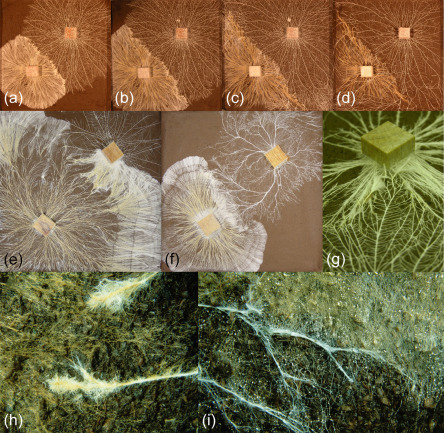
The Mycota, 2007 13 Network Organisation of Mycelial Fungi M. Fricker, L. Boddy, D. Bebber https://mdfricker.files.wordpress.com/2016/01/fricker_et_al-2007-mycota-proof.pdf
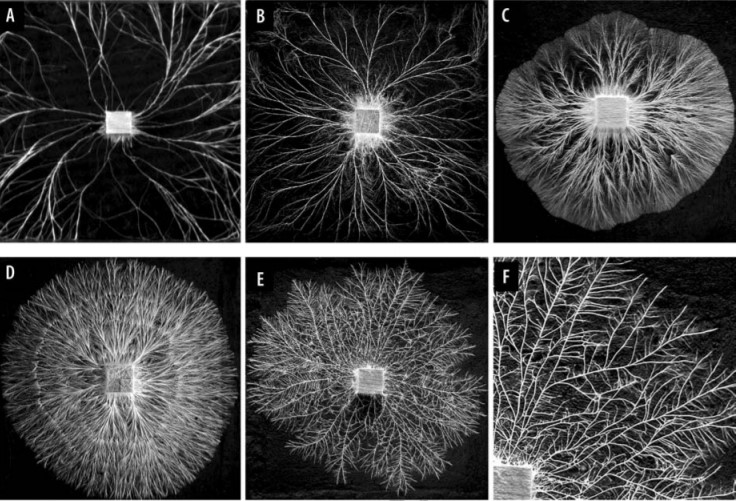
The structure of mycelial cords and rhizomorphs of fungi: A minireview: https://www.mycosphere.org/pdf/MYCOSPHERE_9_5_3.pdf
 (Above) A Apical region of rhizomorph of Armillaria mellea as described by Hartig (1873);
adopted from Garrett (1970). B Apical region of rhizomorph of Armillaria gallica growing in an
agar medium
(Above) A Apical region of rhizomorph of Armillaria mellea as described by Hartig (1873);
adopted from Garrett (1970). B Apical region of rhizomorph of Armillaria gallica growing in an
agar medium
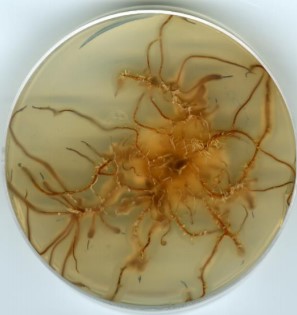 (Above) Root-like structure of Armillaria rhizomorphs in potato dextrose agar medium, after 3
weeks of growth at 30°C
(Above) Root-like structure of Armillaria rhizomorphs in potato dextrose agar medium, after 3
weeks of growth at 30°C
Living Artefacts: Conceptualizing Livingness as a Material Quality in Everyday Artefacts. Elvin Karana, Bahareh Barati 1, and Elisa Giaccardi http://www.ijdesign.org/index.php/IJDesign/article/viewFile/3957/915
Shroomery forum: Stro’s Cleaning and Isolating On Agar: https://www.shroomery.org/forums/showflat.php/Number/18430998/fpart/1/vc/1/nt/3
Shroomology forum: Mushroom Sub-Strain Isolation, by Mush Zombie https://www.shroomology.org/forums/topic/240-mushroom-sub-strain-isolation/
Mycelium Material Producers
https://boltthreads.com/ -  Here you can see how they grow this mass of fluffy mycelium which can then be pressed to different densities to achieve different material properties. I think Ecovative grows theirs in the same way. I heard that by adding c02 to the environment it encourages the fluffy growth.
Here you can see how they grow this mass of fluffy mycelium which can then be pressed to different densities to achieve different material properties. I think Ecovative grows theirs in the same way. I heard that by adding c02 to the environment it encourages the fluffy growth.
MOGU http://mogu.bio
Ecovative Design https://ecovativedesign.com/
Mycotech Lab https://mycl.bio/about
Mycoworks https://www.mycoworks.com/
Muskin by Life materials is a leather-like material made from the fruiting body of Phellinus ellipsoideus https://lifematerials.eu/en/shop/muskin/
Inspirational Art/Design Works:
https://www.lilianvandaal.com/: Designer of biomimicing products
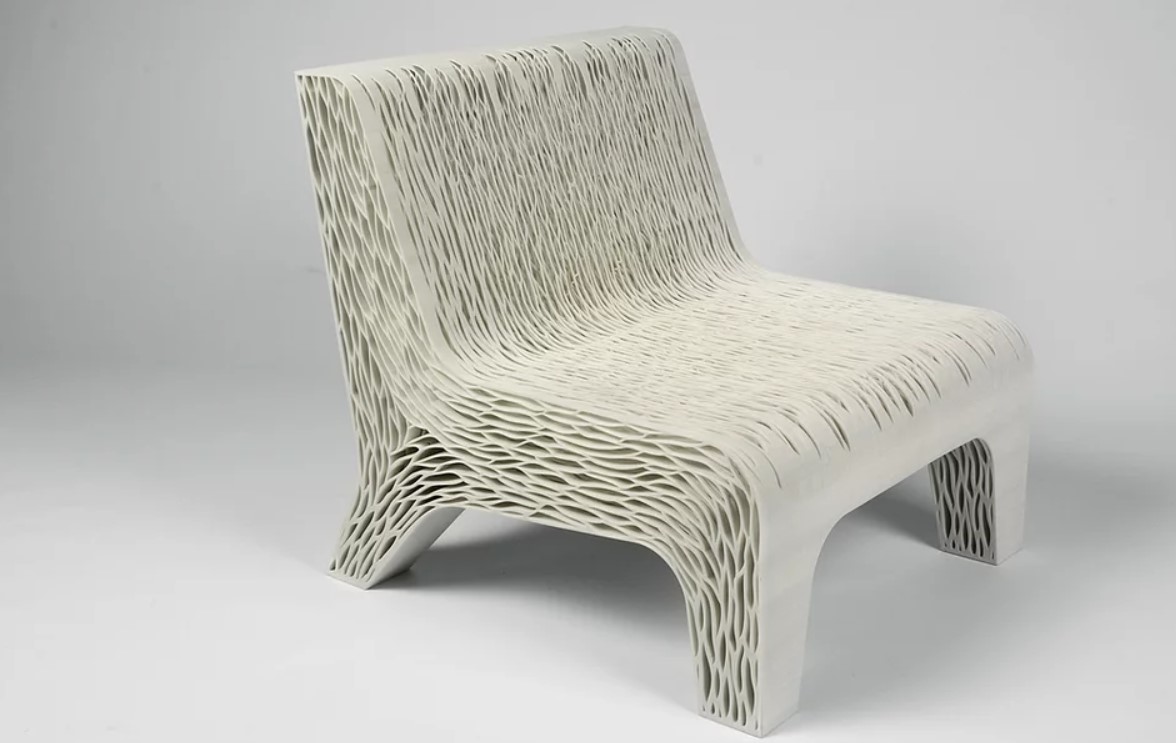
http://www.livinstudio.com/fungi-mutarium
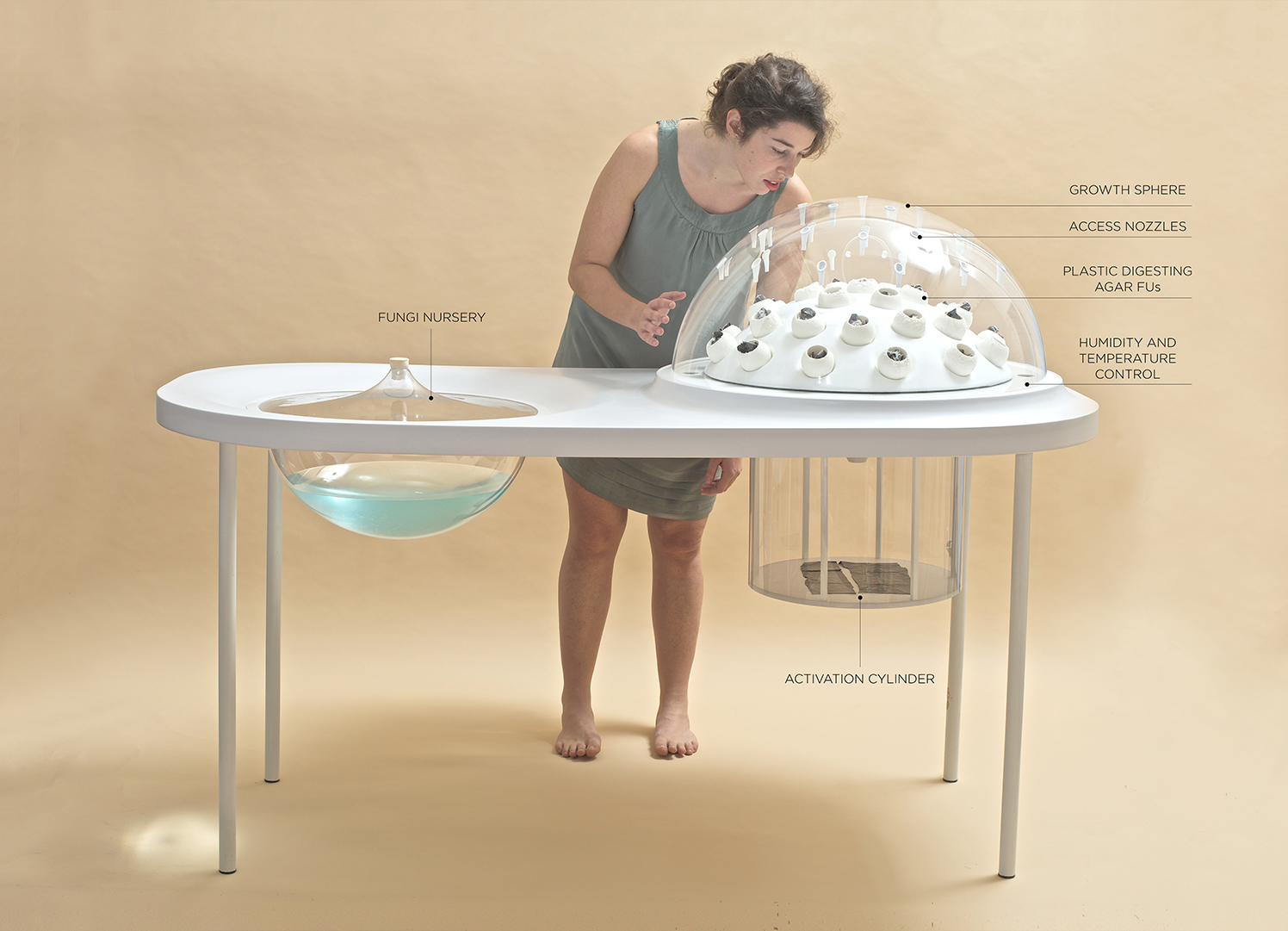
Mycelium species
Buy cultures:
https://www.etsy.com/ie/shop/mushbank?ref=simple-shop-header-name&listing_id=702013116
BOOKS, NOTES & QUOTES
Chemarts Cookbook ## - Pirjo Kääriäinen, Liisa Tervinen, Tapani Vuorinen & Nina Riutta (eds.):
pp17. “Recently, many designers have become excited about experimental material design, often driven by the need to find more sustainable material solutions. However, designers have often worked alone or within the designer community, without proper support to further develop and scale-up their most feasible ideas. At the same time, scientific material research has resulted in ground-breaking findings, which, with help from designers, could be applied in everyday life. As collaboration is crucial for the future, we want to share some tips on how to carry this out in practice.”
pp24. “Recently, many designers have become excited about experimental material design, often driven by the need to find more sustainable material solutions. However, designers have often worked alone or within the designer community, without proper support to further develop and scale-up their most feasible ideas. At the same time, scientific material research has resulted in ground-breaking findings, which, with help from designers, could be applied in everyday life. As collaboration is crucial for the future, we want to share some tips on how to carry this out in practice. "
pp.25 “Designers use their imagination and skills to utilize waste streams, for example, or to create new materials from unexpected sources. In addition to material development projects, designers and artists use speculative design and design fiction to present alternative material futures and to raise awareness of the urgent need for sustainability. Instead of offering solutions, they ask questions and encourage their audience to react – and act. "
pp.27 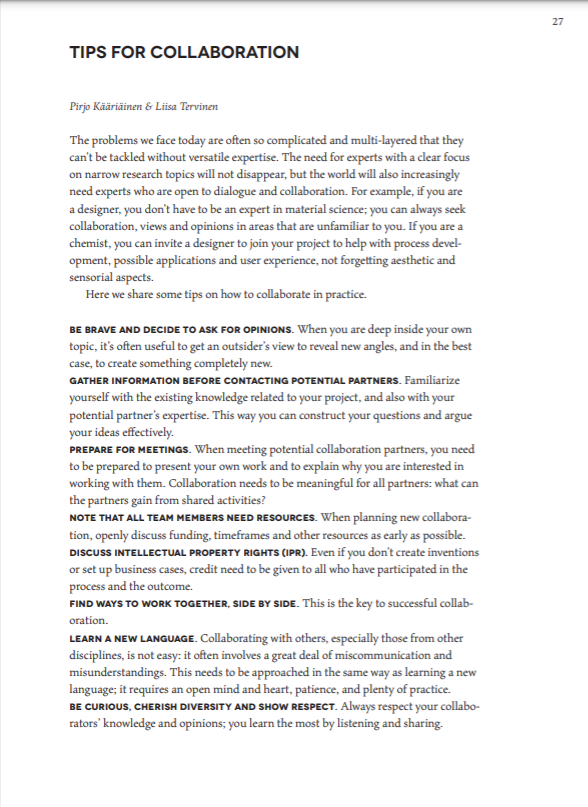
pp.44 “Label material samples clearly and document experiments systematically. During this research, detailed notes were made about the material in a notebook and shared digitally”
-This is important for my practice with the 3D Printing Project settings and prototypes, too.
INSPIRATION (Chapter Name): Quotes which relate to my vision and story for the Mycelium Watch project:
Connections between human well-being and materials from nature
Sara Lucía Rueda Mejía
“During the course, some of the key insights I gained were the type of emotions that arose while handling biobased materials, and the increasing sense of closeness to and oneness with nature. This sense grew every day… Therefore, for me these materials became a media for designing experiences for learning to discover and grasp relationships between emotions and nature.”
Hope needed: Tackling climate anxiety through material experimentation
Yu Chen & Chiao-wen Hsu, 2019
“At the beginning of our project, we sought to create materials associated with certain emotions triggered by climate issues. We decided to focus on using agricultural waste: tomato stems from green house cultivation. However, we soon realized that the emotions linked to the materials varied from one individual to another. Rather than defining the feelings evoked by the materials, we probed into the diverse attributes of biomaterials, enabling them to convey the complexity of our climate-related feelings, and providing the audience with an opportunity to perceive and confront these issues… When dealing with climate change, emotions and feelings are unavoidably aroused, of which we are sometimes unaware of these. Our intention was, through material action, to create awareness of these emotions, engage with the issues, create positive emotions, and take further action to fight against eco-anxiety and climate change, as well as advance social sustainability in accordance with SDG No.3 Good Health and Well-being and environmental sustainability.”
Experiments 1// pp. 118, “The CHEMARTS Cookbook” Colouring PLA with Chlorophyll
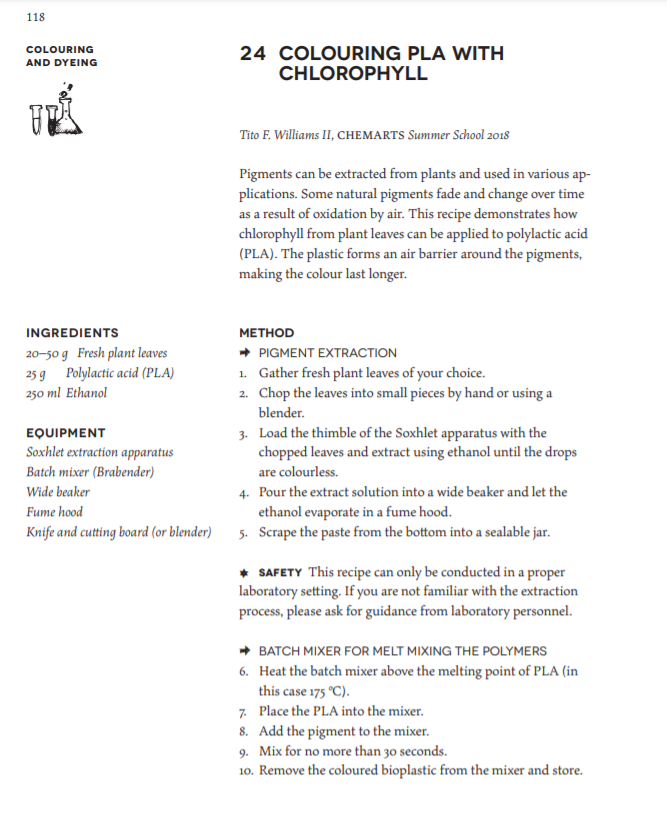
Colouring mycelium with organic and synthetic dyes
Lennert found out that the colour in samples dyed with liquid watercolour stayed visible even after drying:
Those dyed with acrylic paint became discoloured as the mycelium spread:
What about growing a mycelium leather in the mycelium watch ? - grow the strap too? As a bio factory on your wrist
Bio Design: Nature, Science, Creativity by William Myers
Notes & Quotes
pp.6
Collaboration between fields where the different skillsets and perspectives of both parties complement each other, filling in the gaps of eachother’s knowledge and checking each others assumptions:
“Designers fascination with science is today reciprocated by a generation of scientists who are eager to get their brains dirty with reality… these novel collaborations are often joyous contaminations in which scientist feel, even if just for a moment, liberated by the rigor of peer review and free to attempt intuitive leaps”
pp7
If its purpose is to be an educational, ambassadorial project to promote biodesign then the living jewellery piece and its exhibition should, if successful “have the lyrical and demonstrative power of art and the realistic possibilities of design”
pp9
Important questions for the field of biodesign, from the foreword by William Myers:
“Can we avoid thinking of life as simply another material or tool without extending it due respect? Can we unlearn our fear aspects of biology, such as invisible microbes, and embrace a design that utilizes them? Can designers learn to empathise with other forms of life and surrender a small amount of control of their work to them?”
If this new sensitivity of designers to biology and cross-disciplinary collaboration amounts to a paradigm shift for society, how does this shift “compare with other field-changing shifts in the trajectory of technological developments, from industrialization to the invention of computers?”
Chapter 2. Ecological Object Engineering
We are already biodesigning, bio engineering in such fields as pharmaceuticals, food, agri-science and petro(bio)chemicals. These are highly regulated, slow moving industries. There is much fertile ground for the faster paced, less regulated world of product design then, to explore applications of bio-tech which have a lower barrier of entry but still hold many opportunities for facilitating the move to a more circular, bio-inclusive existence for humanity.
pp 88 The project “A Radical Means” by designer Damian Palin shows a less energy intensive method of creating molded, strong products by using a mix of sand and microorganism impregnated minerals which turn the sand into stone over time. The final form is influenced by the growth pattern of the microorganisms. If they don’t spread perfectly then the stool will not appear perfect either, being turned to stone in only some places. The result is more thought provoking than a perfectly mass produced object. Natures role in the design is paid respect to in this way instead of being hidden or forced into an industrial definition of “perfect”.

pp 99 The microbial home project, by Phillips Design working with Jack Mama and Clive van Heerdan, is a concept interior of a home designed to work as an ecosystem, maximising the use of the energy which passes through our homes.
The mycelium jewellery project demonstrates how we might better use just one of the many wasted energy sources created each and every human. In this case the intimate form of often wasted energy - our body heat.

pp 189 The Biological Atelier project, from Amy Congdon at Central Saint Martins' Material Futures program, uses conceptual prototypes inspired by real science in development to show a speculative future where garments are grown, not made.
This is also part of what I want to show with the mycelium jewellery but in a prototype instead of a concept, to make this future more visible and tangible to reach the public’s imagination. People should see it and say: " If this is what is possible now, then what crazy opportunities there must be for biodesign in the future!?”
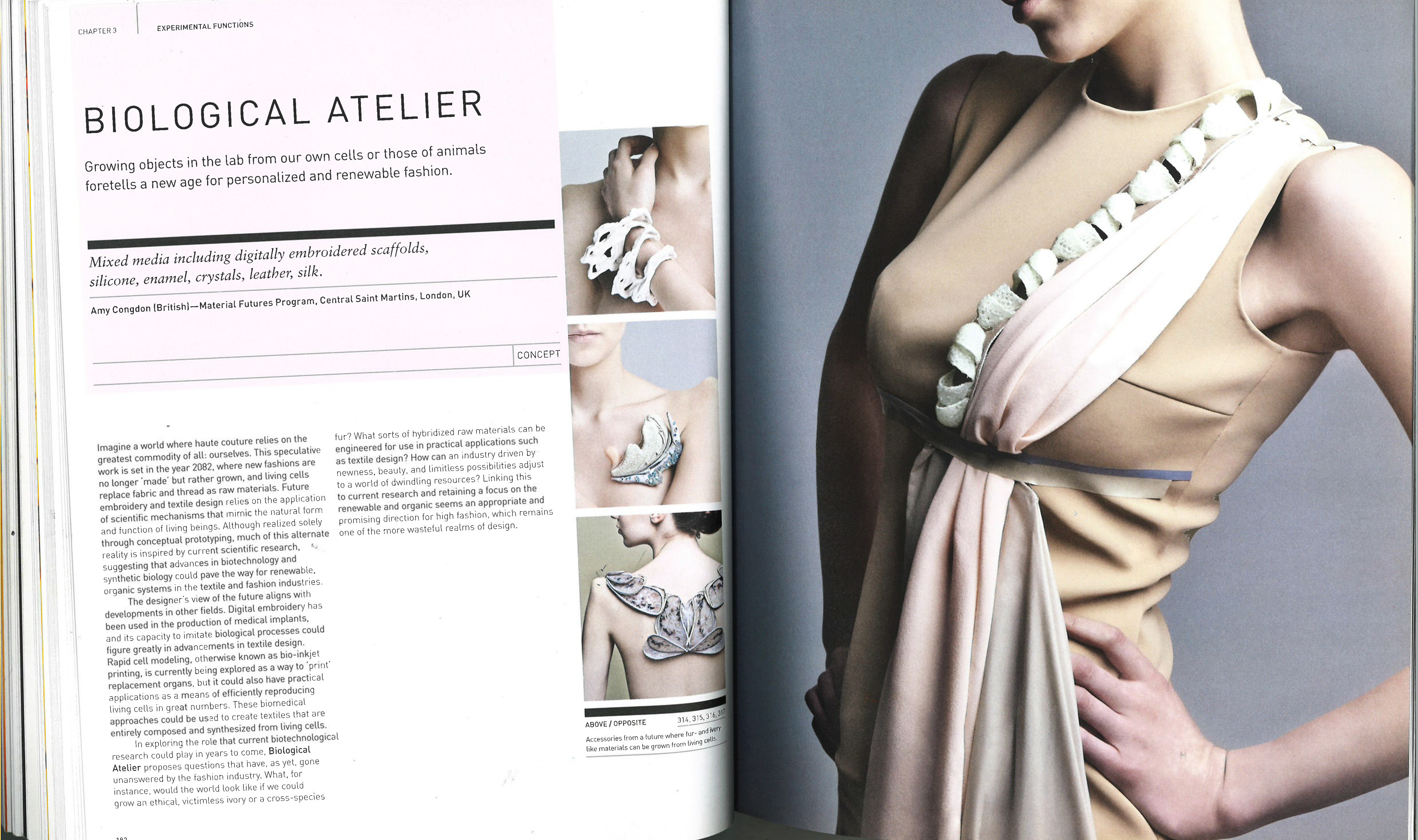
Fantastic Fungi - 2019, Documentary, Louie Schwartzberg:
Points for communicating the importance, possibility of mycelium and, importantly, what it is:
“Fungi are the recyclers of nature” 3:00
Mushrooms signify rebirth, the energy from the dead matter is used to feed the growth of the mushrooms which go on to fertilize the soil and act as a part of the food chain, returning that energy to living. They are the link between death and new life.
Fungi are in between plants and animals, the mycelium jewellery showcases this unique position: you see mycelium searching for food, fighting contamination in an animal like way and also see the fruiting and sporulation reminiscent of a plant. A mini-snapshot of nature’s intelligence happening in real time, including our impact on it via the with climate change via the metaphor of our body heat acting as global warming/ habitat destruction
“A window into the invisible landscape beneath our feet”
Mushrooms and mycelium are the communication system for nature, transferring nutrients from plant to plant in exchange for sugars and even warning of oncoming threats to their plant partners like diseases via their underground network of roots, known as mycelium. They balance the ecosystem and help it respond to changes. There could be many benefits to society to investigate their uses further and work with their capabilities.
They share the nutrients throughout the forest.
Of all the millions of species of fungi about 20000 produce mushrooms.
Mycelium broke the rock sown into soil to enable for the rest of life on land.
Mycelium can break down hydrocarbons into bioavailable nutrients. Could you break plastic down with mycelium and then process it into a biodegradable alternative to plastic?
Kunstformen Der Natuur - Ernst Haeckel
Classic book of illustrations of nature’s living art.
Entangled Life - Merlin Sheldrake
Other
Fast bioluminescence signal spread in a colony of Panellus stipticus “stabbed” by a pipette tip.
https://exploringtheinvisible.com/ - A microbiologist’s blog w/ interesting (micro) photography & other visuals
